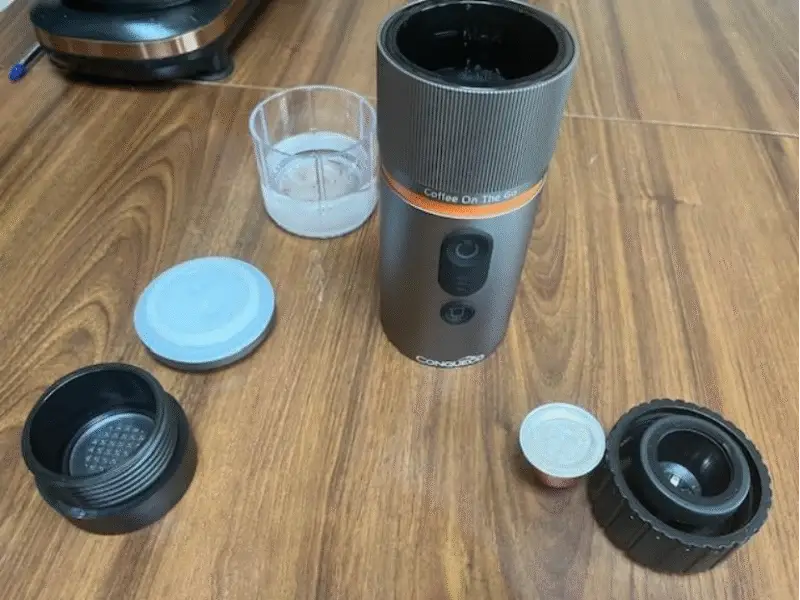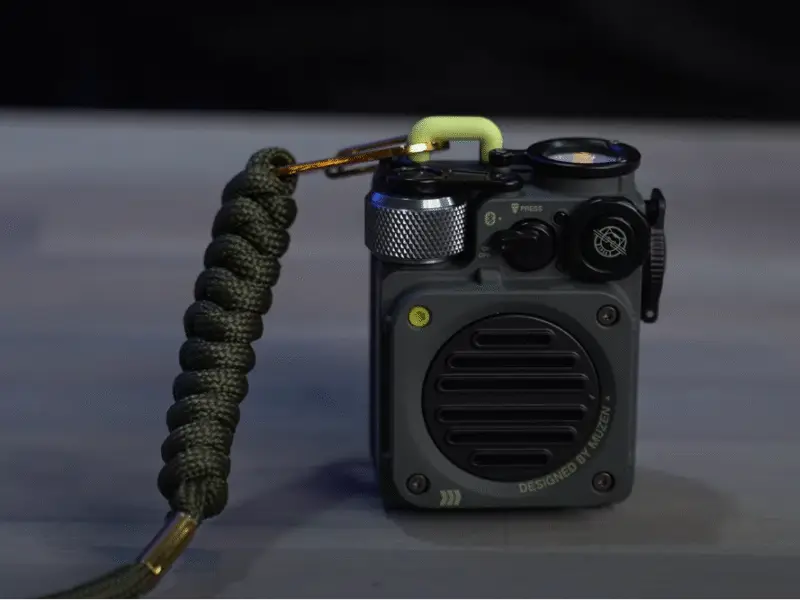It’s always exciting to dive into the world of smart home tech, especially when it promises to make dreaded chores easier!
Today, I’m thrilled to share my journey with the Yarbo Snow Blower, a truly unique piece of yard equipment. So, grab your coffee, let’s talk robots!
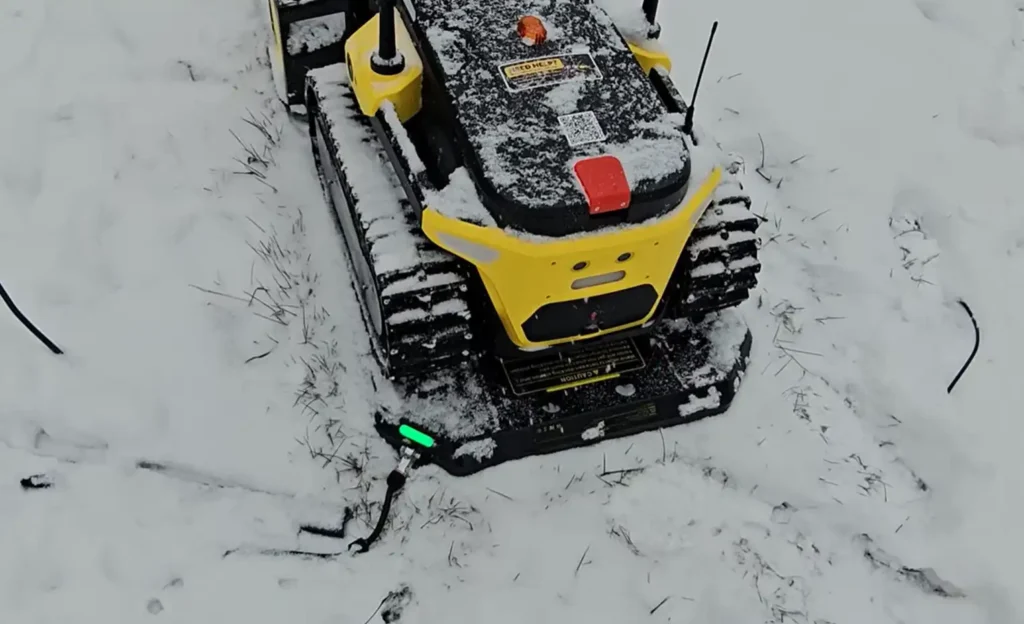
Key Takeaways
- Yarbo is a modular, autonomous yard robot with impressive multi-season capabilities and a standout snow blower module.
- Setup is well-documented and intuitive, but the RTK system’s hardwired internet requirement can be limiting.
- It performs best in dry snow and struggles with wet or icy conditions, sometimes requiring manual intervention.
- Advanced features like person detection, self-navigation, and heated components offer real smart-home integration.
- Ideal for tech-savvy homeowners ready to invest in cutting-edge yard automation, especially those facing regular snowfall.
The Yarbo Snow Blower Robot: A Versatile Solution for Yard Maintenance
The Yarbo is presented as a modular yard robot designed to revolutionize outdoor maintenance. I’ve heard it described as a Powerhouse modular robot tank and a professional and solid robot, definitely not a toy.
What really captured my interest is its versatility, the Yarbo Core unit acts as the base for a whole range of attachments.
Beyond the snow blower, there are modules for lawn mowing (including a Pro version and a trimmer attachment), leaf blowing, granular fertilizer application, liquid fertilizer application, and even a snow plow blade.
It even boasts impressive towing capabilities, pulling up to 500 lbs, with videos showing it towing a car or even a Cybertruck.
For this review, I’ve been specifically focusing on the snow blower configuration, diving deep into the unboxing, setup, operation, and performance to see if this autonomous snow-clearing marvel is truly worth it.
Unboxing and First Impressions of The Yarbo Snow Blower
Let me tell you, when the Yarbo arrived, it came in several large, well-packaged boxes. There’s one for the main robot and separate ones for attachments like the snowblower and the RTK system.
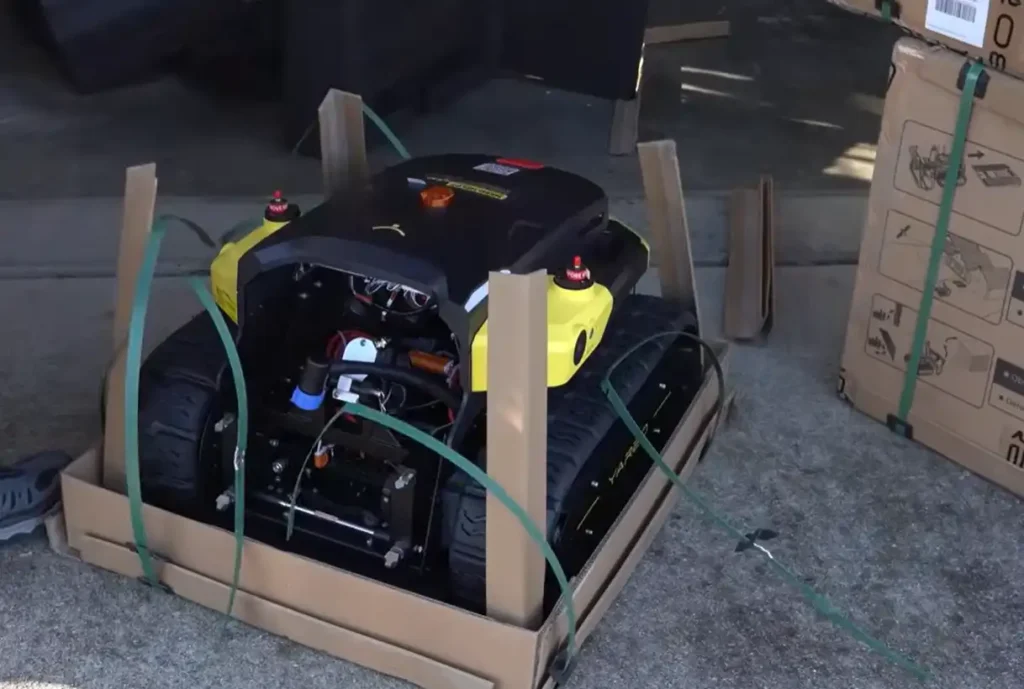
What immediately stood out to me was the organization, everything is incredibly well thought out. They literally include every tool you need for setup, from Allen keys to ratchets and all the necessary screws. Parts are individually labeled and nicely packaged, which made a great first impression.
One of the first things you’ll notice is that this unit is heavy. It weighs upwards of about 100 lbs. Unlike some other yard robots I’ve encountered, you definitely won’t be walking across the lawn and picking it up to carry back to the garage, you’ll want to remote control this thing whenever you move it.
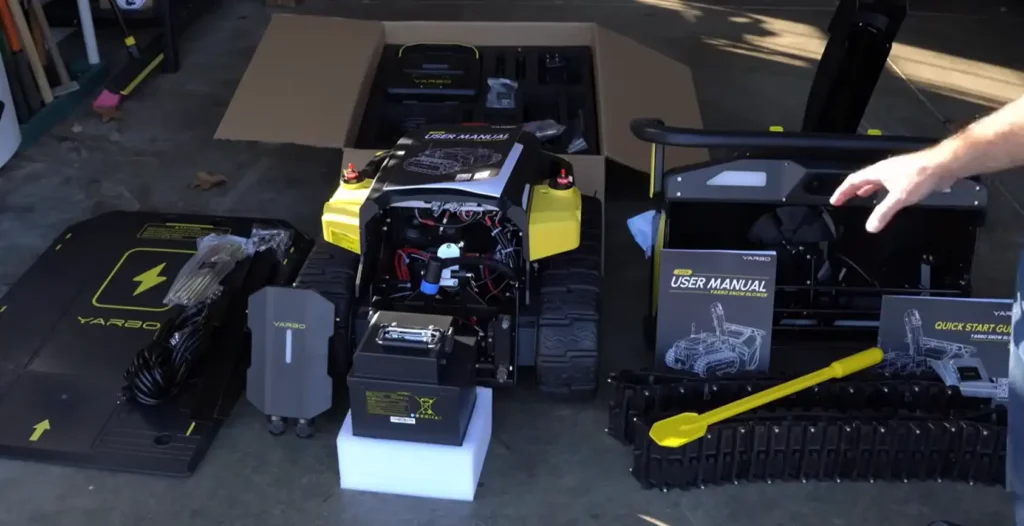
Setup and Installation Process
Getting the Yarbo ready to go was surprisingly straightforward. If you’ve ever put together a Lego set, you’ll find assembly pretty straightforward. The instructions are clear, and they even have helpful video guides on their YouTube channel.
The main robot has a Smart Assist Module or face module that you attach when other modules are off, giving it a clean look and adding features like follow mode and extra cameras.
The RTK (Real-Time Kinematic) system, which they call the Data Center, is crucial for its navigation. This system provides centimeter-level GPS precision and communicates with satellites.
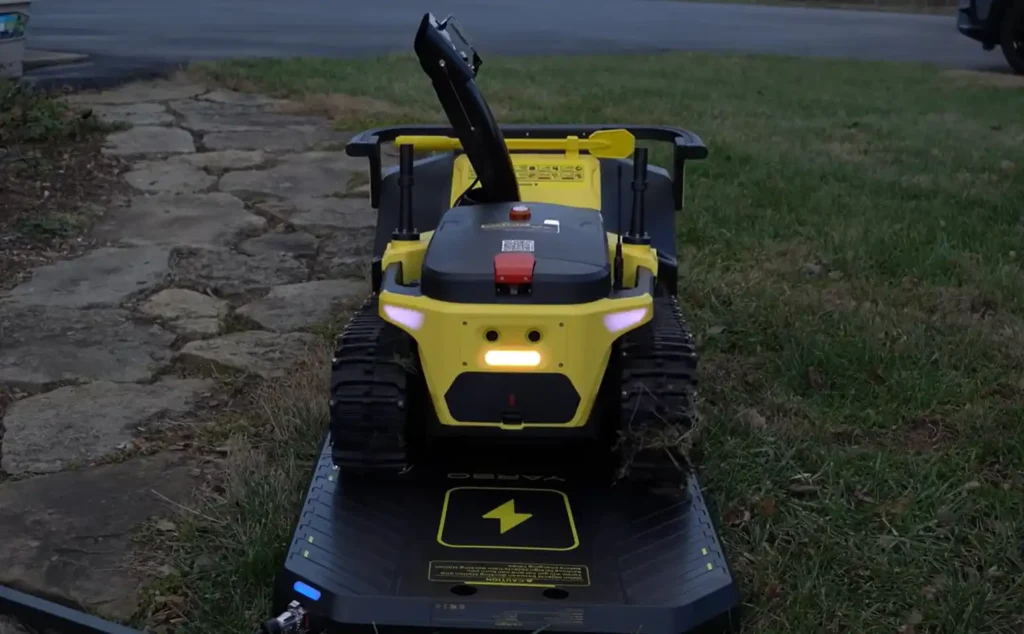
The main “catch” I encountered is that it requires a clear view of the sky for best results, and more importantly, the RTK needs to be hardwired to your home internet via an Ethernet (Cat 5) cable.
This can be a bit of a challenge for outdoor placement, as your router is likely inside. Some users, like me, found workarounds, even installing it inside a garage with high ceilings, though it’s noted this isn’t the proper way.
It also needs to be in a fixed, permanent position, as even moving it by an inch can throw off the robot’s map.
The charging station (docking station) uses a wireless charging system. It also needs to be in an open area to communicate with the RTK.
I found that you can affix it to your driveway using anchors or strong tape, like Flex Seal tape, to avoid drilling holes. A really cool feature I observed is that the robot can clear snow off the charging pad before docking itself.
It’s designed to withstand outdoor environments, so covering it isn’t recommended as it can impair GPS signals.
Mapping the yard was quite intuitive. I just grabbed my phone, opened the Yarbo app, and walked the robot around my yard to define perimeters, areas, and pathways like driveways and sidewalks.
The app is very user-friendly, and you can even split maps into smaller segments for more precise control, which I found helpful for my long, winding driveway.
Battery installation is simple, it connects easily and snaps into place, though you need to unplug it for safety when replacing modules. The snowblower module comes with studded tracks for improved traction in winter conditions.
I opted to remove the metal studs to prevent scratching my new driveway, but this does reduce traction on ice.
Finally, the unit comes with an Xbox-style remote control. I quickly found this to be much easier to use in cold weather with gloves than trying to use my phone.
Features and Smart Capabilities
Once set up, the Yarbo is designed for autonomous operation, capable of clearing snow 24/7 based on scheduled times or manually initiated jobs. It automatically returns to its charging station when needed.
A critical safety feature is its smart obstacle avoidance and detection. It has person detection that causes it to stop for safety, and an obstacle sensor bar that triggers an emergency stop if it hits something.
A great detail is that the cameras also have built-in heaters to prevent snow coverage, which I found worked very very well.
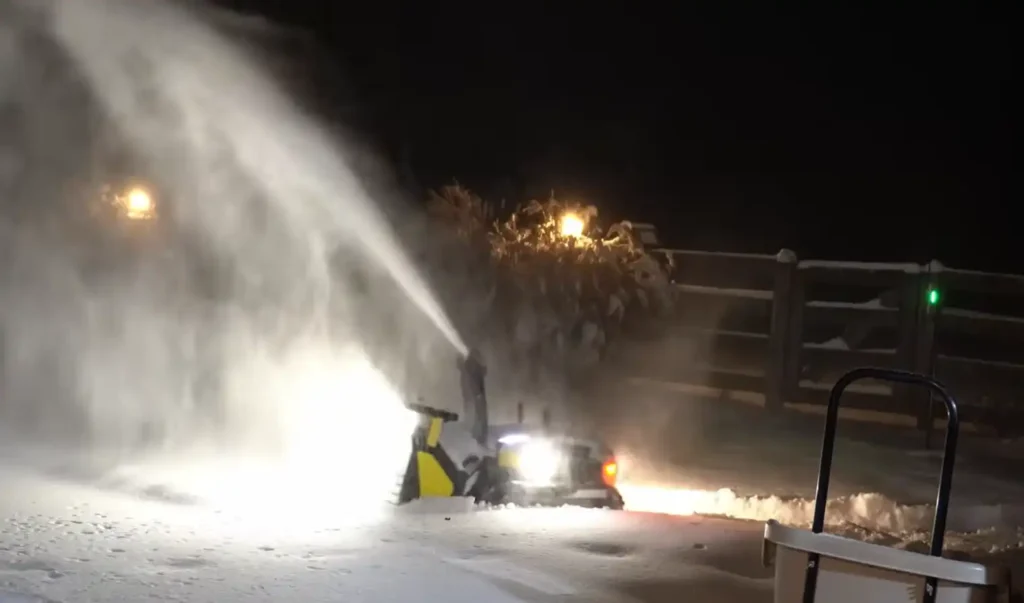
The user-friendly app control is a real highlight, offering extensive customization. I could adjust the auger height (even mid-job), throw direction and chute angle (controlling distance from 6 to 40 feet), speed (a global setting for heavy snow), and auger speed mode (Quiet, Mild, Robust, Turbo).
There are also settings for overlap for a cleaner result and to turn person detection on or off.
A beta feature I tried was the Follow Me Mode, which is really cool. The robot follows you around, which could be useful for moving it to new areas or for towing items.
In terms of operating conditions, the Yarbo is built tough:
* Temperature: It operates from -13°F to +140°F (-25°C to +60°C). It’s even equipped with heating modules for major components like the battery and drivetrain, allowing operation as low as -40°C.
* Slope: It can handle slopes up to 36% (21°).
* Waterproof Level: It boasts an IPX5 rating.
Performance in Real Snow Conditions
Yarbo is rated to clear 6,000 sq.ft (557 m²) per inch of snow depth per charge. It can handle snow depths up to 5 inches (12.7 cm) per full charge, with an impressive 12-inch (30.5 cm) intake height. It operates for about 1.5 hours per charge and takes about 3 hours to fully charge.
My experience with snow types was varied:
* Dry/Fluffy Snow: In these conditions, the Yarbo performs awesome and flawlessly. It truly shines.
* Wet/Sticky/Heavy Snow & Ice: This is where the challenges arise. I found it posed a significant hurdle, leading to clogging, slipping, and getting stuck.
For wet snow, I learned some recommendations:
* Remove the protective fence/grate to allow for smoother discharge.
* Avoid using WD-40; a ceramic coating spray is recommended instead to prevent clogging.
* Consider adding weight to the module to improve traction and reduce slipping, especially in muddy or uneven areas.
Traction and slipping were noticeable, particularly on icy or wet surfaces, even with the studded tracks.
However, I was impressed that Yarbo often self-corrects by moving forward and back to free the tracks. While it got itself unstuck most of the time, there were a couple of times I had to manually intervene.
In terms of clearing quality, as a two-stage snow blower, it may not clear right down to the pavement like a paddle design, but it gets the job done. It can leave some residue, especially with wet snow. Running multiple passes and adjusting the auger height can improve results significantly.
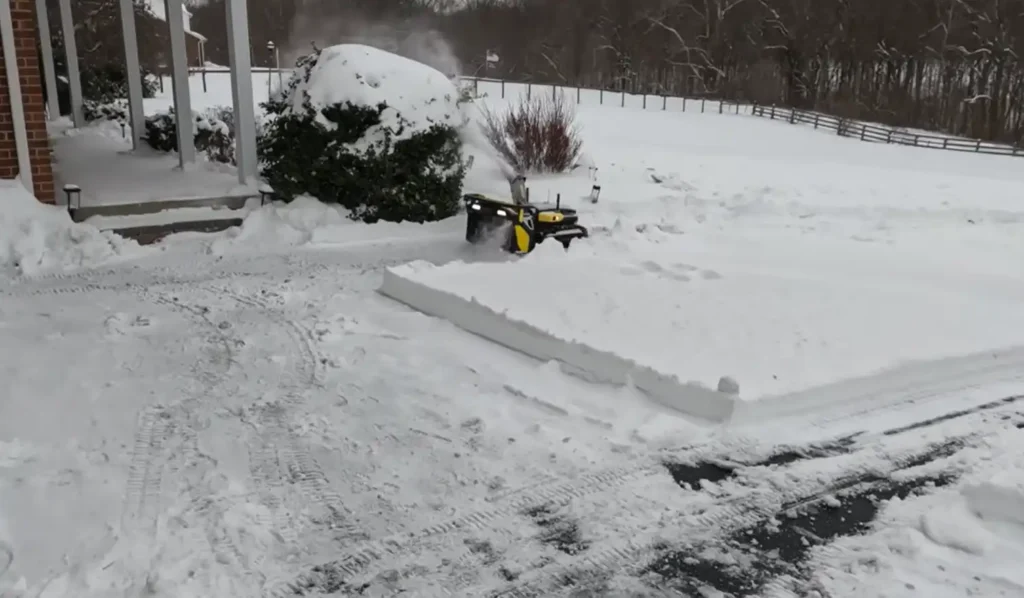
Yarbo is designed to adapt to various surfaces, including masonry, cement, asphalt, grass, and smooth/rough tiles. It can also handle small steps and irregularities up to 1.97 inches (5 cm), including cracks in sidewalks.
I also learned that the plow module is recommended for light, sticky wet snow, while the blower is better for deeper, dry snow.
To prevent excessive snow accumulation, it’s highly recommended to schedule automatic snow removal before forecasted snowfalls or run it multiple times throughout a storm. This proactive approach can make a huge difference in overall performance.
Maintenance and Troubleshooting
I experienced a few common issues that are good to be aware of:
* Clogging: Wet snow definitely clogged the chute and auger channel. Luckily, a cleaning tool is provided, and it was easy to clear.
* Shear Pins: I actually “broke” the Yarbo when a rock jammed one of the augers. Thankfully, the system uses shear pins, which are designed to break to protect the motor and auger. Replacement pins are included and easy to install, which was a huge relief.
* Track Issues: Under extreme conditions like ice buildup, the tracks can be thrown off. This requires manual reinstallation, which can be a pain.
* Connectivity/GPS Issues: Initially, I faced frustrations with the app communicating with Yarbo and acquiring a GPS signal. This was often resolved by cycling power on the robot and data center, or through automatic firmware updates that seemed to correct the problems.
* Charging Alignment: I also learned the hard way that the robot needs to be properly aligned on the charging pad for the inductive coils to energize and start charging.
Pros and Cons of the Yarbo Snow Blower
After my extensive testing, I have some mixed feelings, but overall, there’s a lot to like and some areas for improvement.
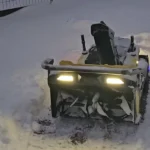
Key Strengths
* Versatile Modular Design: This is the absolute standout feature. It truly allows for year-round yard maintenance with one core unit, easily swapping attachments.
* Robust Construction: The unit feels well-engineered, well-made, and built of heavy metal; it’s definitely not a toy.
* Organized Packaging and Easy Assembly: The thoughtful packaging, clear instructions, and inclusion of all necessary tools made setup much less daunting than expected.
* Advanced Autonomous Capabilities: Its smart route planning, obstacle detection, self-adjustment (like getting unstuck), and automatic docking/recharging are impressive.
* Effective in Ideal Conditions: In light, fluffy, dry snow, it performs flawlessly and is awesome.
* Heating Modules: The built-in heating for components like cameras and the battery allows it to operate in very cold temperatures.
* Impressive Battery Life and Fast Charging: I found the battery life quite good, and it charges quickly on its wireless pad.
* Good Customer Support and Updates: The company seems committed to improvement, offering responsive support and regular firmware updates.
* Remote Control: The Xbox-style controller is a practical and convenient way to operate it, especially in cold weather.
Areas for Improvement
* Challenges with Wet/Heavy/Icy Snow: This was my biggest frustration. It frequently slips, gets stuck, and clogs in these conditions, often requiring manual intervention.
* Hardwired RTK: The requirement for an Ethernet connection to the home internet for the RTK system can limit placement options and create cabling challenges. I really wish they could get rid of that hardwire setup and connect via Wi-Fi in the future.
* Potential for Driveway Scratching: The studded tracks can scratch new paved surfaces if the studs are not removed.
* Does Not Always Clear to Pavement: Like many two-stage blowers, it can leave a thin layer of snow or ice.
* High Price Tag: This is a premium product with a premium price tag, making it a significant investment.
* Initial Frustration during Setup and First Use: I definitely experienced some initial headaches with connectivity and getting it to perform as expected.
* Heavy Weight: If it gets stuck or runs out of battery, it’s “way too heavy to carry”.
Final Verdict and Recommendations
My feelings about the Yarbo are quite mixed, a blend of appreciation for its engineering and acknowledgment of its real-world limitations. It’s a truly cool product and well made in many ways.
I’d say the Yarbo Snow Blower is best suited for early adopters who are tolerant of rough edges, enjoy tinkering with gadgets, and for whom thousands of dollars feels like chump change.
It truly shines as a tool for proactive snow clearing, where you run it multiple times throughout a storm or schedule it before forecasted snowfalls to prevent excessive accumulation. If you wait for deep, heavy snow, you might find yourself manually intervening more often.
For me, it has the potential to be a godsend for clearing tricky spots and significantly reduces manual labor, especially if run on a consistent schedule. The modularity is a brilliant concept, and I’m genuinely excited about its potential.
The company is actively improving the product with firmware updates, and I’m hopeful for future enhancements, such as better underbelly clearance and the ability for the RTK to connect wirelessly.
If you’re looking for an autonomous solution to yard maintenance and are willing to embrace the learning curve, the Yarbo offers a glimpse into the future of effortless yard care.

